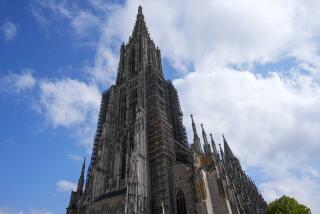Tiny Church Is an Outsize Attraction
HIGHLANDVILLE, Mo. — Giant. Awesome. Imposing.
These are the words used to describe the world’s most famous cathedrals--from the Middle Ages masterpiece Notre Dame de Paris to the London landmark St. Paul’s.
Bishop Karl Pruter has heard none of them to describe his own cathedral. Instead, he hears: tiny, cramped, curious.
The Guinness Book of Records calls it the “smallest cathedral in the world.”
Consecrated in 1983, the one-room structure measures 15 by 17 feet and has a 7-foot-tall ceiling.
Like the white-haired bishop himself, the Cathedral of the Prince of Peace is plain and humble, made of Ozark stone with just a touch of quirkiness: A bulbous, turquoise-colored cupola rests atop the building, reminiscent of Russian churches.
Still, the tiny church with seating for 15 has tremendous magnetism. Thousands have traveled from across the country and as far away as Germany to look, pray and stroll through the three-acre Garden of Saints, which winds through a nearby wheat field.
“Sometimes during Sunday Mass we get wall-to-wall people, so many that they have to stand outside,” the 80-year-old bishop says. “But I have such a booming voice, when I preach all can hear.”
Pruter, with thick black glasses and a billy-goat beard, belongs to the Old Catholic Movement, a small group of Christians who practice the orthodox faith of the ancient undivided Catholic church. The movement, numbering in the thousands, claims to have roots going back to AD 325.
The doors to Pruter’s cathedral remain open most of the day. Inside, votive candles burn on the altar and icons of Jesus, Mary and St. Peter adorn the walls.
One of the bishop’s favorite art objects--a painting of St. Peter and his wife--hangs near the altar. Pruter, who is married, says it is a reminder that the first pope was also married, as were many of his successors until the 8th century. The Old Catholic Movement allows clergy to wed, unlike Roman Catholicism.
On the opposite wall is a painting by Thomas Fundora, titled “The Back of Christ,” done in 1954. Pruter said the painting was to show what one would see in following Christ, but not all saw it that way.
“Some people were so angry when they saw this painting depicting Christ’s back that they broke into Fundora’s studio and broke both of his hands. He couldn’t paint for 11 years,” Pruter says.
Over the altar is a copper engraving of “The Last Supper,” and in the center of the altar rests a 100-year-old tabernacle.
The building’s one window is filled with a stained-glass depiction of Christ seated on a throne and holding a tablet with the word “PAX” inscribed on it.
Outside the church, a path leads visitors on a tour of the Garden of Saints, adorned by lilies, shrubs and overarching trees. Along the path are tiny wooden and stone statues of Our Lady of Guadalupe, St. Anthony and others; Pruter calls them “the greatest heroes.”
“I’m hoping my heroes someday replace the heroes that our kids worship today--people like Michael Jackson and Madonna,” Pruter says. He pauses, reflecting on the task. “Well, I can always pray.”
More to Read
Sign up for Essential California
The most important California stories and recommendations in your inbox every morning.
You may occasionally receive promotional content from the Los Angeles Times.








